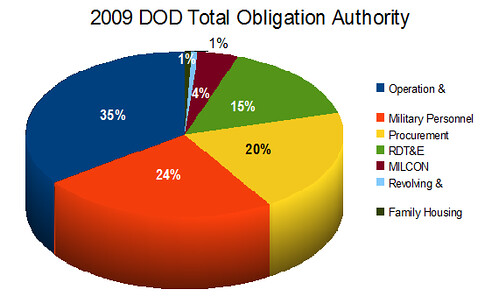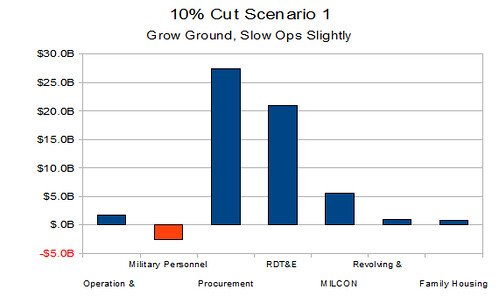Obama Gutting the Navy
CDR Salamander asks (at his place)
$55 billion? What does the Navy throw on the alter? At the low end, I would think that we will have to eat at least 30% of that - let's call it $18.3 billion that needs to go as a baseline.
His question at the USNI blog gets right to the point: Which child do you sell first?
Lets check the numbers.
According to the 2009 budget (Figure 2 on page 1-14), the planned Navy Department top line budget was $152.8 billion. The 10% cut if applied to all of the services would mean $15.3 billion, taking the budget down to $137.5 billion. Phibian's $18.3 billion would put the top line at $134.5 billion. The lowest Navy top line in the Bush administration budgets was $140.6 billion (constant FY09 dollars). Capabilities will have to be cut. Let's assume that Phibian got it right and the $18.3 number is the real deal. The question is, where?
I'll assume that Marine Corps personnel accounts will go up by 6% to meet President Obama's stated goal of increasing the ground forces, and that Navy personnel accounts will go down to pay that bill. That will take 2.5% out of the active account and 10% out of the reserves. Combined with the pay rate increases, a 2.5% funding cut is probably a 6% end strength reduction, from the current 337K down to about 311K.
Next, whack 25% from MILCON and housing accounts. This saves us $1.2 billion, but will be nearly impossible to sell in a Congress dependent on those accounts.
Six percent increases in Marine Corps O&M (to support the 6% increase in personnel expenses) mean we need to cut 20% from Navy Reserve O&M and 10% from the active side. This results in a net savings of $3.4 billion (about 10%), so now our top line budget is down by $4.6 billion. This leaves $13.7 billion that must come from either procurement or R&D funds. Twenty percent from R&D would be about $3.9 billion, so the remaining $9.2 billion has to come out of procurement.
Level loading that $9.2 billion across the procurement accounts, we would need to cut each by 24%. That means the cuts would be broken down along the following lines:
Aircraft - $3.5 billion
Shipbuilding and Conversion - $3.1 billion
Other Procurement - $1.3 billion
Weapons - $0.9 billion
National Defense Sealift Fund - $0.5 billion
Marine Corps - $0.4 billion
Ammunition - $0.2 billion
Achieving these reductions is going to be very difficult, and will disrupt ongoing contracts in significant ways. Take aircraft procurement as an example. To cut $3.5 billion, we could eliminate all of the non-combat aircraft, and still have to cut 40 out of 155 combat aircraft. Spares and Support equipment costs would probably have to go up because of the additional wear and tear on the existing fleet.
Shipbuilding and Conversion is probably even harder to cut than aircraft. The unit quantities are so low right now that deferring a ship for a year just increases its net cost. The FY09 new construction account was $11.1 billion for seven ships. Killing the FY10 DDG (either flavor) and the 10 th LPD 17 is probably the only viable option to get $3.1 billion.
We need $1.3 billion out of OPN. The biggest lines available there are ship support equipment ($1.7 billion) and communications equipment ($2 billion). A lot of those dollars are related to shipbuilding, so it may be that they come down naturally if we cut ships. $900 million from weapons procurement can be approached if we cut all of our 2009 tactical missile and torpedo purchases in half, or if we forgo a year of Trident II upgrades and make moderate cuts to other programs.
Whatever approach our naval leadership takes in response to the president's direction, it is going to be painful. Making cuts like these while the military is still fighting a war is irresponsible if not dangerous. And as I pointed out in my previous post, it is a false savings. Eliminating billions from defense procurement only to shift those funds into unemployment accounts is a net reduction in the productivity of the American economy, and a huge cut to the military power of the United States.
To the good Commander, I'm afraid the answer may be "all of them."


